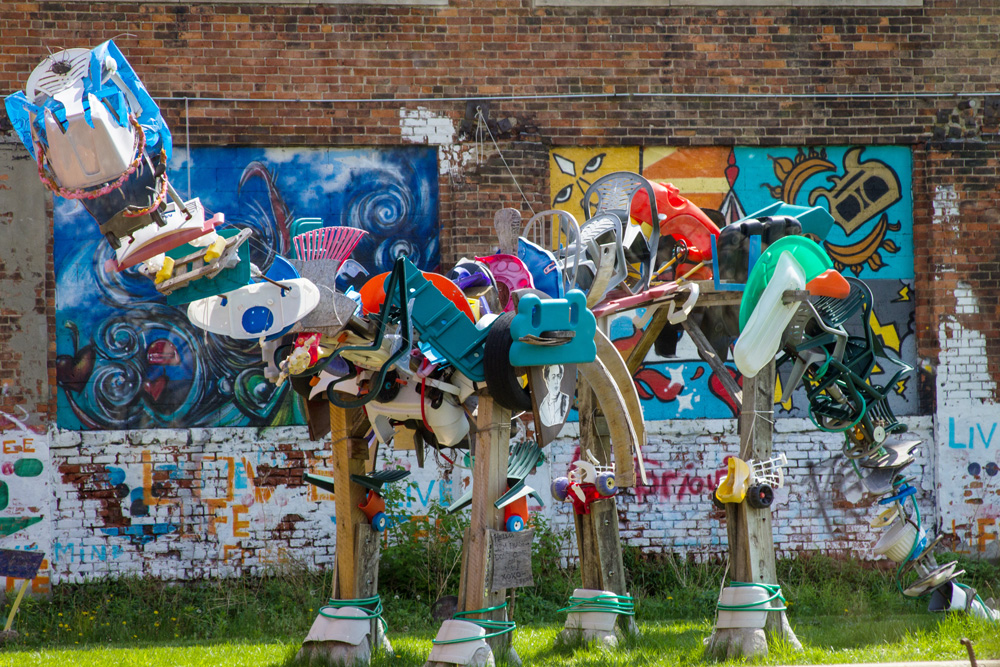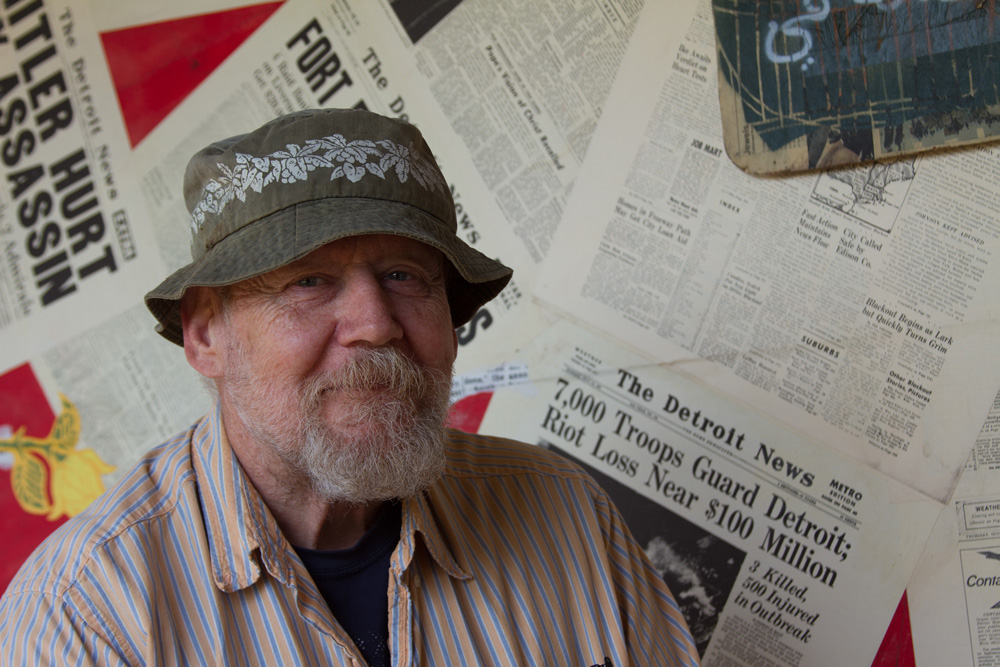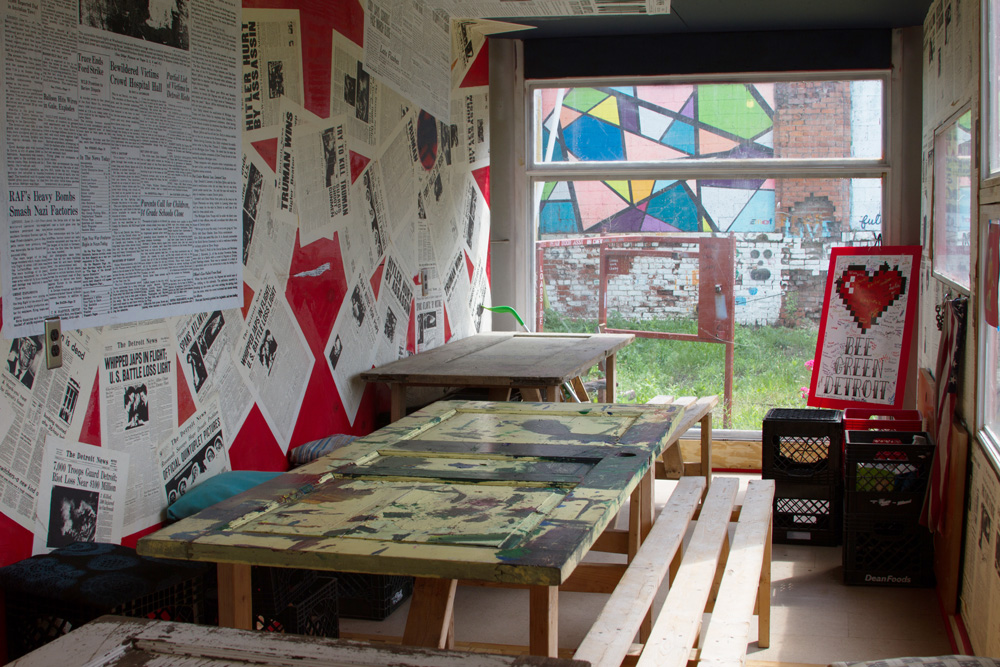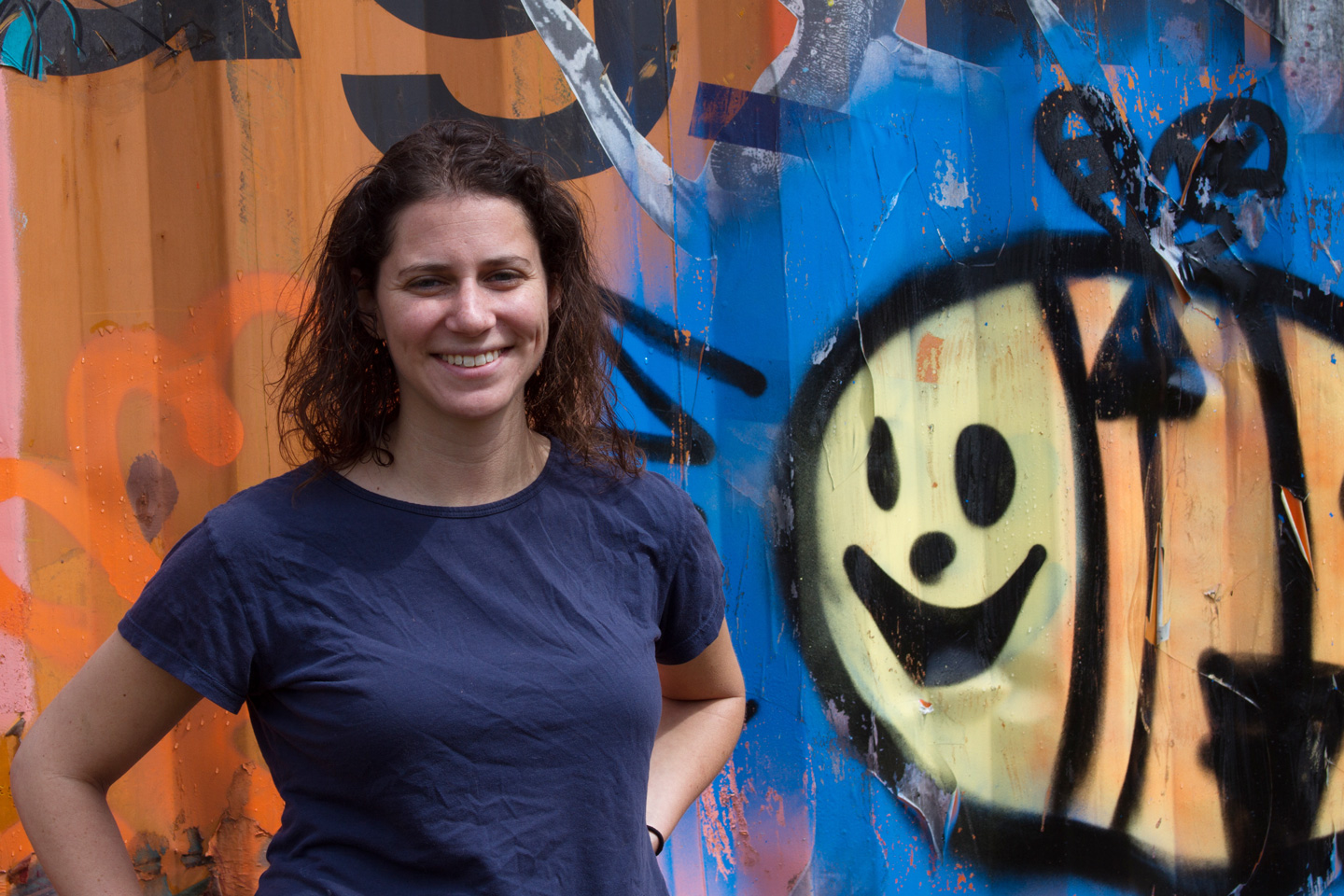Rachel Klegon: On Green Living Science
By Vivian Henoch, Editor myJewishDetroit
July 1, 2015
If you have yet to see it, make a vow to find the astonishing Lincoln Street Art Park & Sculpture Garden this summer. Some call it the Ghetto Louvre of Detroit. Reclaimed from an illegal dumping ground behind the former Lincoln plant on the edge of Midtown and the Woodbridge neighborhood, the park is situated just east of Trumbull Avenue and Holden Street. You can’t miss the signs; “Recycle Here!” they proclaim.
It’s one of those partly sunny mornings in June where the sky is about to burst into a summer shower. Amidst bright murals, street art and funky sculptures — recycled from tossed-and-found objects — one can’t help but wonder: are we standing in a passing whimsy, just a moment in time?

How is this wild urban landscape changing the quality of life for residents of the city and what will it look like in another decade’s span?
Will it still be a vast warehouse for recycling the city’s trash?
Will its cavernous interiors still be a vibrant workspace for some of the area’s most prominent artists? (And will its roof still leak?)
Will its garden grow into something of more prominence and permanence as testimant to the spirit and renewal of Detroit?
Even on an ordinary business day, the vibe is totally cool here, as we meet Rachel Klegon at the door of the main office location at 1331 Holden. Rachel – recently listed among Crain’s Business 2015 20 in their 20’s – can be counted among the Detroit millennials finding their place, their purpose and their home in the city. As Executive Director of the nonprofit Green Living Science (GLS), she runs the educational components of Recycle Here! and the Lincoln Street Art Park.

“Bee Green”
In partnership with Recycle Here!, Rachel began working with the Detroit Public Schools (DPS) in 2007. With the mission to transform Detroit by teaching the principles of recycling, she has since reached out to more than 40,000 students to influence personal choices and family behavior that encourage the Three R’s – Reduce, Recycle, Reuse.
Founded by Matthew Naimi, Recycle Here! started as a grassroots initiative in 2005 and has grown into a fully funded citywide program with recent expansion to curbside recycling for residents of Detroit.
“We have an incredible network here,” Rachel explains, as we walk through the labyrinthine complex towards the Lincoln Street entrance to the park. “There are more than 40 artists who work with us. On the recycling side, we get about 2,000 visitors per week. When the city started to offer curbside recycling, we thought we’d see our numbers drop at the recycling center. If anything, we’ve seen an increase. Every Saturday, I’m here talking to recyclers as they come in and they say that they enjoy coming here, enjoy what we’ve been able to create and what they feel they have helped to build here and be a part of.”
The Activi-Tree
Household batteries, old TVs, computers and electronics, plastic and Styrofoam containers, newspapers, old books . . . Recycle Here! takes it all. But even to the most casual observer, there’s more going on here than the salvage of recyclable materials.
Community is everything here.
In the grand Detroit tradition of Trash-Turned-to-Art, the Lincoln Street Art Park & Sculpture Garden was founded in 2011 through a successful community Kickstarter campaign. Now a program under the auspices of Green Living Science, the Park serves as a creative hub, where the community can come together, engage and explore through a full calendar of public events and activities.
Among the major sculptural installations in the Park, visitors now find the Activi-Tree, a 40-foot intermodal container repurposed as an on-site classroom. Inside, the walls have been papered with front-page news reprints telling the stories of Detroit’s rich heritage. Picnic-style tables crafted from recycled doors serve as seating for groups of 20.
As Rachel describes how the plans for the Activi-Tree include summer workshops for DPS school groups using street-art materials and stencils, in walks Eno Laget, the street artist principally responsible for the design of the project.

As if on cue, Eno arrives just in time get out of the downpour that has begun to rattle the metal walls of Activi-Tree. “This isn’t really my design,” he says. “It’s been a collaboration, where more than 20 people have been involved. There’s something elemental and comforting as we sit together, listening to the rain and chatting about the future of the project, which is possibly slated for a showing at ArtPrize 2015 in Grand Rapids later this summer.
“I’m a street artist,” Eno claims, “I work in stencils on paper. Most of my stuff is made to disappear, not meant to be permanent.”
“There’s a real and wholesome synergy that has occurred here in Detroit,” he continues. “Those of us who have been living and working here for the last 30 years have come to realize that no one is coming to save Detroit. We are required to work cooperatively and to rely upon each other. What’s cool about Detroit now is its stunning contradictions. You can have all the things going on downtown . . . and you also can have this other kind of synergy building in the neighborhoods. The blueprint for our future is being drawn today – and maybe this [kind of creative urban development] is a piece of it.”
Still growing
What’s next for Green Living Science? With Rachel at the helm, the curriculum now has aligned with Michigan science standards in lessons that heavily incorporate the different STEAM (Science, Technology, Engineering, Art and Math) disciplines.

“We are very focused on urban issues, specifically in Detroit,” says Rachel. “But the work we’ve been doing in DPS is uniquely qualified to replace a Third Grade unit in science. The lessons are fun. And we know that they work as an effective catalyst in creating environmental awareness and behavioral change with students – and their parents.”
Can Green Living Science be replicated as a model for other cities? Absolutely. “As educators, we talk about relating lessons in school to the real world,” Rachel reminds us. “Detroit’s trash problem is in plain sight. We’ve demonstrated that empowering people – so they can make a difference in their homes and their communities – is the best sustainable solution for cities on the whole. I would love the opportunity for GLS to teach our curriculum to every single third grade class in the city – and for every one one of those students to come here on a field trip.”
Big goals right now
Recycling may be an important step and new to Detroit. But according to Green Living Science, recycling can be used as a powerful tool to teach whole communities about new and creative ways of thinking about the environment and rebuilding sustainable cities.
Beyond its program in Detroit schools, Green Science Living has developed “Bee Green Business,” a program to encourage recycling in the business community. Early adopters that have been certified in the program include Hospice of Michigan, Walker Energy Services and Café 14 East.
Interested? For more information on all things recycled, repurposed and remarkably creative, “Bee Green” and contact Rachel Klegon at Green Living Science. Rachel@GreenLivingScience.org 313.871.4000




